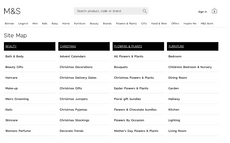On-page SEO refers to the visible, front end changes made on a website to boost its performance in Google.
This includes:
- Updating the H1 tags
- Optimising title tags
- Implementing various internal linking tactics
- Meta description edits
- Optimising your content for E-E-A-T
Some SEOs would also fit tech SEO within this bracket, however, this is a bit of a grey area in the SEO world.
Below you will find our top 5 on page SEO recommendations for a brand that is just starting out, and wants to see long-term success.
1. Implement long breadcrumbs on your product and category pages.
Breadcrumbs are not only great for user experience but are also great for SEO.
They are really easy for Google to crawl and are an efficient way to show search engines the hierarchy of a website.
Breadcrumbs are also a great use of internal linking that supports the performance of subcategories and product pages as well as being helpful on category pages.
We recommend marking your breadcrumbs up with a breadcrumb list schema for a rich result in Google.
2. Ensure that your homepage has an H1
At NOVOS, we come across so many brands that don’t have an H1 (heading 1) on their homepage.
H1’s are a direct communication to Google on what the page is about. Google uses this information to decide what keywords it should rank you for.
The homepage is one (if not the) strongest page on your website, so it’s important that it is optimised to its full capacity and includes information on what your business is about, and your most important keywords.
Below, highlighted by the red arrow, is NOVOS’ H1. It’s eye-catching and interesting for the user, whilst also highlighting to Google what our website is about and the services we offer.
You can use chrome extensions like SEO Meta in one Click (see image below) to check the odd page, or crawlers like Screaming Frog to identify mass pages missing them.
3. Create an HTML sitemap that links to your core category and subcategory pages.
HTML sitemaps are a great way to boost internal linking on a site, and give Google a direct path to its most important URLs.
They are particularly effective on larger eCommerce sites that are difficult to navigate around and are super easy to put together, as they don’t require much (if any) development work.
When creating an HTML sitemap, we only recommend linking to category and subcategory pages as product pages tend to go in and out of stock more frequently.
Sitemaps are most effective when they are linked to from the footer menu so Google can find and crawl it more efficiently.
Below is an example from M&S:
4. Add content to the top of your category pages
We recommend adding two to three sentences of copy to the top of each category page, telling Google and users what the page is about and what type of products are available.
Remember to include some variations of the targeted keywords, as well as key USPs and delivery times etc.
You can also use this opportunity to link to other product categories and relevant blog posts like the example from Mr. Porter below.
What to avoid:
- Long chunky paragraphs that push the products further down the page
- Keyword stuffing
- Information that would normally sit within FAQs / blog content
5. Optimise your product names for Google
We often see eCommerce sites come up with funny names for their products e.g. ‘moo’ for dog food, ‘Ken’ for a plant or a tagline like ‘Please leave by 9 pm.’
*Try searching these terms in Google and you’ll get some interesting results*
Whilst these are fun and memorable marketing tactics they aren’t easy for Google to understand.
Google Bot is getting smarter and smarter, but it still needs context to understand a product name.
Make sure to add what the product is after the product name to give Google more context e.g. ‘Old fashioned cocktail’ instead of just “Old Fashioned.’
For more information on how to optimise your product pages, check out our blog post on ‘The Ultimate Guide to Optimising Product Pages for SEO.’
To summarise
- Implement long breadcrumbs on category, subcategory, and product pages
- Make sure your homepage has an H1
- Optimise your product names for Google
- Add content to the top of your category pages
- Create an HTML sitemap and link to it from your footer menu
Looking to learn more about On-Page SEO? Check out some of our other blog posts:
- How to optimise your Shopify site for E-A-T
- 7 Common SEO Mistakes eCommerce Sites Make and How to Correct Them
- How to leverage internal linking on eCommerce websites
If you want to understand more about how you can improve your On-Page SEO, get in contact with us today.





